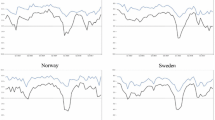Abstract
In this paper, genetic programming (GP) is employed to model learning and adaptation in the overlapping generations model, one of the most popular dynamic economic models. Using a model of inflation with multiple equilibria as an illustrative example, we show that our GP-based agents are able to coordinate their actions to achieve the Pareto-superior equilibrium (the low-inflation steady state) rather than the Pareto inferior equilibrium (the high-inflation steady state). We also test the robustness of this result with different initial conditions, economic parameters, GP control parameters, and the selection mechanism. We find that as long as the survival-of-the-fittest principle is maintained, the evolutionary operators are only secondarily important. However, once the survival-of-the-fittest principle is absent, the well-coordinated economy is also gone and the inflation rate can jump quite wildly. To some extent, these results shed light on the biological foundations of economics.
Similar content being viewed by others
Explore related subjects
Discover the latest articles and news from researchers in related subjects, suggested using machine learning.Author information
Authors and Affiliations
Rights and permissions
About this article
Cite this article
Chen, S., Yeh, C. Modeling the expectations of inflation in the OLG model with genetic programming. Soft Computing 3, 53–62 (1999). https://doi.org/10.1007/s005000050053
Issue Date:
DOI: https://doi.org/10.1007/s005000050053




